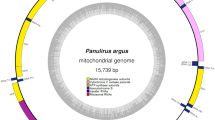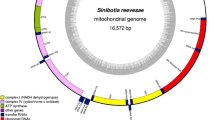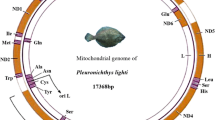Abstract
The genetics and molecular biology of the commercially important Chinese spiny lobster, Panulirus stimpsoni are little known. Here, we present the complete mitochondrial genome sequence of P. stimpsoni, determined by the long polymerase chain reaction and primer walking sequencing method. The entire genome is 15,677 bp in length, encoding the standard set of 13 protein-coding genes, two ribosomal RNA genes, and 22 transfer RNA genes. The overall A + T content of the genome is 65.6%, lower than most malacostracan species. The gene order is consistent with the pancrustacean ground pattern. Several conserved elements were identified from P. stimpsoni control region, viz. one [TA(A)]n-block, two GA-blocks and three hairpin structures. However, the position of [TA(A)]n-block and number of hairpin structure are different from those in the congeneric P. japonicus and other decapods. Phylogenetic analyses using the concatenated nucleotide and amino acid sequences of 13 protein-coding genes do not support the monophyly of suborder Pleocyemata, which is in contrast to most morphological and molecular results. However, the position of Palinura and Astacidea is unstable, as represented by the basal or sister branches to other Reptantia species. P. stimpsoni, as the second species of Palinura with complete mitochondrial genome available, will provide important information on both genomics and conservation biology of the group.




Similar content being viewed by others
References
Boore JL (1999) Animal mitochondrial genomes. Nucleic Acids Res 27:1767–1780. doi:10.1093/nar/27.8.1767
Wolstenholme DR (1992) Animal mitochondrial DNA: structure and evolution. Int Rev Cytol 141:173–216. doi:10.1016/S0074-7696(08)62066-5
Boore JL, Macey JR, Medina M (2005) Sequencing and comparing whole mitochondrial genomes of animals. Methods Enzymol 395:311–348. doi:10.1016/S0076-6879(05)95019-2
Kim SR, Kim MI, Hong MY, Kim KY, Kang PD, Hwang JS, Han YS, Jin BR, Kim I (2009) The complete mitogenome sequence of the Japanese oak silkmoth, Antheraea yamamai (Lepidoptera: Saturniidae). Mol Biol Rep 36:1871–1880. doi:10.1007/s11033-008-9393-2
Liu Y, Cui Z (2009) Complete mitochondrial genome of the Asian paddle crab Charybdis japonica (Crustacea: Decapoda: Portunidae): gene rearrangement of the marine brachyurans and phylogenetic considerations of the decapods. Mol Biol Rep. doi:10.1007/s11033-009-9773-2
Holthuis LB (1991) Marine Lobsters of the World. An annotated and illustrated catalogue of species of interest to fisheries known to date. FAO Species Catalogue 13:125. FAO, Rome
Wang KX, Wu QS, Ji CL (1996) Proliferation of Shrimps and Crab. China Agriculture Publisher, Beijing
Wei SQ (1985) Ontogenesis of the Chinese loster Panulirus stimpsoni (Holthuis). J Tropic Oceanogr 4:80–90
Chen ZQ, Chen CS, Wu ZQ, Gu LS, Ji DH (2000) Feeding habit of Chinese spiny lobster (Panulirus stimpsoni). Marine Fish Res 21:43–48
Chen ZQ, Chen CS, Huang YC, Huang ZL (2006) The growing characteristics and accelerating ways for growth of the spiny lobster, Panulirus stimpsoni. Marine Sci 30:25–31
Martin JW, Davis GE (2001) An updated classification of the recent crustacea. Natural History Museum of Los Angeles County, Los Angeles
Sambrook J, Russell DW (2001) Molecular cloning: a laboratory manual. Cold Spring Harbor Laboratory Press, New York
Folmer O, Black M, Hoeh W, Lutz R, Vrijenhoek R (1994) DNA primers for amplification of mitochondrial cytochrome c oxidase subunit I from diverse metazoan invertebrates. Mol Mar Biol Biotechnol 3:294–299
Lavrov DV, Brown WM, Boore JL (2004) Phylogenetic position of the Pentastomida and (pan)crustacean relationships. Proc R Soc Lond B 271:537–544. doi:10.1098/rspb.2003.2631
Boore JL, Brown WM (2000) Mitochondrial genomes of Galathealinum, Helobdella, and Platynereis: sequence and gene arrangement comparisons indicate that Pogonophora is not a phylum and Annelida and Arthropoda are not sister taxa. Mol Biol Evol 17:87–106
Cheng S, Chang SY, Gravitt P, Respess R (1994) Long PCR. Nature 369:684–685. doi:10.1038/369684a0
Ewing B, Green P (1998) Basecalling of automated sequencer traces using phred. II. Error probabilities. Genome Res 8:186–194. doi:10.1101/gr.8.3.186
Ewing B, Hillier L, Wendl M, Green P (1998) Basecalling of automated sequencer traces using phred. I. Accuracy assessment. Genome Res 8:175–185. doi:10.1101/gr.8.3.175
Gordon D, Abajian C, Green P (1998) Consed: a graphical tool for sequence finishing. Genome Res 8:195–202. doi:10.1101/gr.8.3.195
Wyman SK, Jansen RK, Boore JL (2004) Automatic annotation of organellar genomes with DOGMA. Bioinformatics 20:3252–3255. doi:10.1093/bioinformatics/bth352
Lowe TM, Eddy SR (1997) tRNAscan-SE: a program for improved detection of transfer RNA genes in genomic sequence. Nucleic Acids Res 25:955–964. doi:10.1093/nar/25.5.955
Zhang DX, Szymura JM, Hewitt GM (1995) Evolution and structural conservation of the control region of insect mitochondrial-DNA. J Mol Evol 40:382–391
Zhang DX, Hewitt GM (1997) Insect mitochondrial control region: a review of its structure, evolution and usefulness in evolutionary studies. Biochem Syst Ecol 25:99–120
Kuhn K, Streit B, Schwenk K (2008) Conservation of structural elements in the mitochondrial control region of Daphnia. Gene 420:107–112. doi:10.1016/j.gene.2008.05.020
Mathews DH, Disney MD, Childs JL, Schroeder SJ, Zuker M, Turner DH (2004) Incorporating chemical modification constraints into a dynamic programming algorithm for prediction of RNA secondary structure. Proc Natl Acad Sci USA 101:7287–7292. doi:10.1073/pnas.0401799101
Lohse M, Drechsel O, Bock R (2007) OrganellarGenomeDRAW (OGDRAW): a tool for the easy generation of high-quality custom graphical maps of plastid and mitochondrial genomes. Curr Genet 52:267–274. doi:10.1007/s00294-007-0161-y
Tamura K, Dudley J, Nei M, Kumar S (2007) MEGA4: molecular evolutionary genetics analysis (MEGA) software version 4.0. Mol Biol Evol 24:1596–1599. doi:10.1093/molbev/msm092
Thompson JD, Gibson TJ, Plewniak F, Jeanmougin F, Higgins DG (1997) The ClustalX windows interface: flexible strategies for multiple sequence alignment aided by quality analysis tools. Nucleic Acids Res 25:4876–4882. doi:10.1093/nar/25.24.4876
Xia X, Xie Z, Salemi M, Chen L, Wang Y (2003) An index of substitution saturation and its application. Mol Phylogenet Evol 26:1–7. doi:10.1016/S1055-7903(02)00326-3
Xia X, Xie Z (2001) DAMBE: software package for data analysis in molecular biology and evolution. J Hered 92:371–373
Huelsenbeck JP, Ronquist F (2001) MRBAYES: Bayesian inference of phylogenetic trees. Bioinformatics 17:754–755. doi:10.1093/bioinformatics/17.8.754
Guindon S, Gascuel O (2003) A simple, fast, and accurate algorithm to estimate large phylogenies by maximum likelihood. Syst Biol 52:696–704. doi:10.1080/10635150390235520
Posada D, Crandall KA (1998) MODELTEST: testing the model of DNA substitution. Bioinformatics 14:817–818. doi:10.1093/bioinformatics/14.9.817
Abascal F, Zardoya R, Posada D (2005) ProtTest: selection of best-fit models of protein evolution. Bioinformatics 21:2104–2105. doi:10.1093/bioinformatics/bti263
Hua J, Li M, Dong P, Xie Q, Bu W (2009) The mitochondrial genome of Protohermes concolorus Yang et Yang 1988 (Insecta: Megaloptera: Corydalidae). Mol Biol Rep 36:1757–1765. doi:10.1007/s11033-008-9379-0
Zhang YY, Xuan WJ, Zhao JL, Zhu CD, Jiang GF (2009) The complete mitochondrial genome of the cockroach Eupolyphaga sinensis (Blattaria: Polyphagidae) and the phylogenetic relationships within the Dictyoptera. Mol Biol Rep. doi:10.1007/s11033-009-9944-1
Yamauchi M, Miya M, Nishida M (2002) Complete mitochondrial DNA sequence of the Japanese spiny lobster, Panulirus japonicus (Crustacea: Decapoda). Gene 295:89–96. doi:10.1016/S0378-1119(02)00824-7
Shen X, Ren J, Cui Z, Sha Z, Wang B, Xiang J, Liu B (2007) The complete mitochondrial genomes of two common shrimps (Litopenaeus vannamei and Fenneropenaeus chinensis) and their phylogenomic considerations. Gene 403:98–109. doi:10.1016/j.gene.2007.06.021
Boore JL, Lavrov DV, Brown WM (1998) Gene translocation links insects and crustaceans. Nature 392:667–668
Yang JS, Nagasawa H, Fujiwara Y, Tsuchida S, Yang WJ (2008) The complete mitochondrial genome sequence of the hydrothermal vent galatheid crab Shinkaia crosnieri (Crustacea: Decapoda: Anomura): a noval arrangement and incomplete tRNA suite. BMC Genom 9:257. doi:10.1186/1471-2164-9-257
Shen X, Sun M, Wu Z, Tian M, Cheng H, Zhao F, Meng X (2009) The complete mitochondrial genome of the ridgetail white prawn Exopalaemon carinicauda Holthuis, 1950 (Crustacean: Decapoda: Palaemonidae) revealed a novel rearrangement of tRNA gene. Gene 437:1–8. doi:10.1016/j.gene.2009.02.014
Miller AD, Austin CM (2006) The complete mitochondrial genome of the mantid shrimp Harpiosquilla harpax, and a phylogenetic investigation of the Decapoda using mitochondrial sequences. Mol Phylogenet Evol 38:565–574. doi:10.1016/j.ympev.2005.10.001
Peregrino-Uriarte AB, Varela-Romero A, Muhlia-Almazan A, Anduro-Corona I, Vega-Heredia S, Gutierrez-Millan LE, De la Rosa-Velez J, Yepiz-Plascencia G (2009) The complete mitochondrial genomes of the yellowleg shrimp Farfantepenaeus californiensis and the blue shrimp Litopenaeus stylirostris (Crustacea: Decapoda). Comp Biochem Physiol D 4:45–53. doi:10.1016/j.cbd.2008.10.003
Shen X, Wang H, Ren J, Tian M, Wang M (2010) The mitochondrial genome of Euphausia superba (Prydz Bay) (Crustacea: Malacostraca: Euphausiacea) reveals a novel gene arrangement and potential molecular markers. Mol Biol Rep 37:771–784
Ojala D, Montoya J, Attardi G (1981) tRNA punctuation model of RNA processing in human mitochondria. Nature 290:470–474
Saito S, Tamura K, Aotsuka T (2005) Replication origin of mitochondrial DNA in insects. Genetics 171:1695–1705. doi:10.1534/genetics.105.046243
Podsiadlowski L, Bartolomaeus T (2006) Major rearrangements characterize the mitochondrial genome of the isopod Idotea baltica (Crustacea: Peracarida). Mol Phylogenet Evol 40:893–899. doi:10.1016/j.ympev.2006.04.008
Schram FR (1986) Crustacea. Oxford University Press, New York
Kim W, Abele LG (1990) Molecular phylogeny of selected decapod crustaceans based on 18S rRNA nucleotide sequences. J Crustacean Biol 10:1–13
Abele LG (1991) Comparisons of morphological and molecular phylogeny of the Decapoda. Mem Qld Mus 31:101–108
Scholtz G, Richter S (1995) Phylogenetic systematics of the reptantian Decapoda (Crustacea, Malacostraca). Zool J Linn Soc 113:289–328
Ahyong ST, O’Meally D (2004) Phylogeny of the Decapoda Reptantia: resolution using three molecular loci and morphology. Raff Bull Zool 52:673–693
Tsang LM, Ma KY, Ahyong ST, Chan T-Y, Chu KH (2008) Phylogeny of Decapoda using two nuclear protein-coding genes: origin and evolution of the Reptantia. Mol Phylogenet Evol 48:359–368. doi:10.1016/j.ympev.2008.04.009
Bracken H, Toon A, Felder D, Martin J, Finley M, Rasmussen J, Palero F, Crandall KA (2009) The Decapod tree of life: Compiling the data and moving toward a consensus of decapod evolution. Arthropod Syst Phylogenetics 67:99–116
Ivey JL, Santos SR (2007) The complete mitochondrial genome of the Hawaiian anchialine shrimp Halocaridina rubra Holthuis, 1963 (Crustacea: Decapoda: Atyidae). Gene 394:35–44. doi:10.1016/j.gene.2007.01.009
Acknowledgments
We thank Prof. Chu Ka Hou for editorial comments on this manuscript, Prof. Xinzheng Li for specimen identification and Mr. Ping Zhang for assistance in bioinformatics analyses. This research was supported by the National Natural Science Foundation of China (No. 40676085, No. 40976088) and Chinese National ‘863’ Project (No. 2006AA10A406) to Dr. Zhaoxia Cui.
Author information
Authors and Affiliations
Corresponding author
Electronic supplementary material
Below is the link to the electronic supplementary material.
Rights and permissions
About this article
Cite this article
Liu, Y., Cui, Z. Complete mitochondrial genome of the Chinese spiny lobster Panulirus stimpsoni (Crustacea: Decapoda): genome characterization and phylogenetic considerations. Mol Biol Rep 38, 403–410 (2011). https://doi.org/10.1007/s11033-010-0122-2
Received:
Accepted:
Published:
Issue Date:
DOI: https://doi.org/10.1007/s11033-010-0122-2




